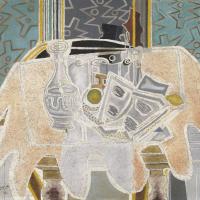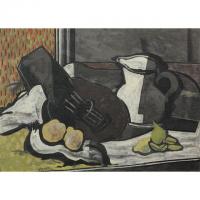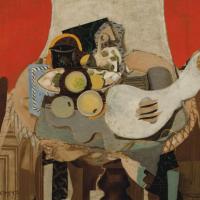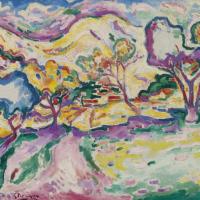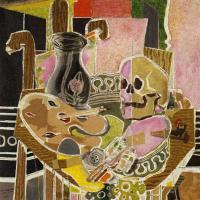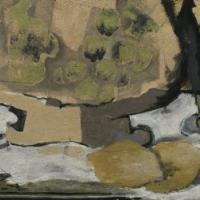Georges Braque
El Mantel Rosa
$450.00
LÕoiseaux Bleu Et Gris
$450.00
Mandoline
$450.00
Nature Morte A La Guitare
$450.00
Paysage La Ciotat
$450.00
Studio With Skull
$510.00
Verre Et Compotier
$450.00
Georges Braque
Georges Braque (13 May 1882 – 31 August 1963) was a major 20th-century French painter, collagist, draughtsman, printmaker and sculptor. His most important contributions to the history of art were in his alliance with Fauvismfrom 1906, and the role he played in the development of Cubism. Braque’s work between 1908 and 1912 is closely associated with that of his colleague Pablo Picasso. Their respective Cubist works were indistinguishable for many years, yet the quiet nature of Braque was partially eclipsed by the fame and notoriety of Picasso.
Georges Braque was born on 13 May 1882 in Argenteuil, Val-d'Oise. He grew up in Le Havre and trained to be a house painter and decorator like his father and grandfather. However, he also studied artistic painting during evenings at the École des Beaux-Arts, in Le Havre, from about 1897 to 1899. In Paris, he apprenticed with a decorator and was awarded his certificate in 1902. The next year, he attended the Académie Humbert, also in Paris, and painted there until 1904. It was here that he met Marie Laurencin and Francis Picabia.
Braque's earliest works were impressionistic, but after seeing the work exhibited by the artistic group known as the "Fauves" (Beasts) in 1905, he adopted a Fauvist style. The Fauves, a group that included Henri Matisse and André Derain among others, used brilliant colors to represent emotional response. Braque worked most closely with the artists Raoul Dufy and Othon Friesz, who shared Braque's hometown of Le Havre, to develop a somewhat more subdued Fauvist style. In 1906, Braque traveled with Friesz to L'Estaque, to Antwerp, and home to Le Havre to paint.
In May 1907, he successfully exhibited works of the Fauve style in the Salon des Indépendants. The same year, Braque's style began a slow evolution as he became influenced by Paul Cézanne who had died in 1906 and whose works were exhibited in Paris for the first time in a large-scale, museum-like retrospective in September 1907. The 1907 Cézanne retrospective at the Salon d'Automne greatly affected the avant-garde artists of Paris, resulting in the advent of Cubism.
Braque's paintings of 1908–1912 reflected his new interest in geometry and simultaneous perspective. He conducted an intense study of the effects of light and perspective and the technical means that painters use to represent these effects, seeming to question the most standard of artistic conventions.
Beginning in 1909, Braque began to work closely with Pablo Picasso who had been developing a similar proto-Cubist style of painting. At the time, Pablo Picasso was influenced by Gauguin, Cézanne, African masks and Iberian sculpture while Braque was interested mainly in developing Cézanne's ideas of multiple perspectives.
A decisive time of its development occurred during the summer of 1911, when Georges Braque and Pablo Picasso painted side by side in Céret in the French Pyrenees, each artist producing paintings that are difficult—sometimes virtually impossible—to distinguish from those of the other. In 1912, they began to experiment with collage and Braque invented the papier collé technique.
On 14 November 1908, the French art critic Louis Vauxcelles, in his review of Georges Braque's exhibition at Kanhweiler's gallery called Braque a daring man who despises form, "reducing everything, places and a figures and houses, to geometric schemas, to cubes".
Vauxcelles, on 25 March 1909, used the terms "bizarreries cubiques" (cubic oddities) after seeing a painting by Braque at the Salon des Indépendants.
The term 'Cubism', first pronounced in 1911 with reference to artists exhibiting at the Salon des Indépendants, quickly gained wide use but Picasso and Braque did not adopt it initially.
The two artists' productive collaboration continued and they worked closely together until the beginning of World War I in 1914, when Braque enlisted with the French Army. In May 1915, Braque received a severe head injury in battle at Carency and suffered temporary blindness. He was trepanned, and required a long period of recuperation.
Braque resumed painting in late 1916. Working alone, he began to moderate the harsh abstraction of cubism. He developed a more personal style characterized by brilliant color, textured surfaces, and—after his relocation to the Normandy seacoast—the reappearance of the human figure. He painted many still life subjects during this time, maintaining his emphasis on structure. One example of this is his 1943 work Blue Guitar, which hangs in the Allen Memorial Art Museum. During his recovery he became a close friend of the cubist artist Juan Gris.
He continued to work during the remainder of his life, producing a considerable number of paintings, graphics, and sculptures.
Braque died on 31 August 1963 in Paris. He is buried in the cemetery of the Church of St. Valery in Varengeville-sur-Mer, Normandy whose windows he designed. Braque's work is in most major museums throughout the world.
On 20 May 2010, the Musée d'Art Moderne de la Ville de Paris reported the overnight theft of five paintings from its collection. The paintings taken were Le pigeon aux petits pois (The Pigeon with the Peas) by Pablo Picasso, La Pastorale by Henri Matisse, L'Olivier Près de l'Estaque (Olive Tree near Estaque) by Georges Braque, La Femme à l'Éventail [fr] (Woman with a Fan) by Amedeo Modigliani and Nature Morte aux Chandeliers (Still Life with Chandeliers) by Fernand Léger and were valued at €100 million ( $123 million USD). A window had been smashed and CCTV footage showed a masked man taking the paintings. Authorities believe the thief acted alone. The man carefully removed the paintings from their frames, which he left behind.


